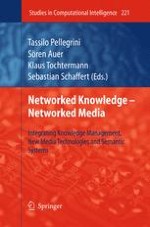2009 | Book
Networked Knowledge - Networked Media
Integrating Knowledge Management, New Media Technologies and Semantic Systems
Editors: Tassilo Pellegrini, Sóren Auer, Klaus Tochtermann, Sebastian Schaffert
Publisher: Springer Berlin Heidelberg
Book Series : Studies in Computational Intelligence
